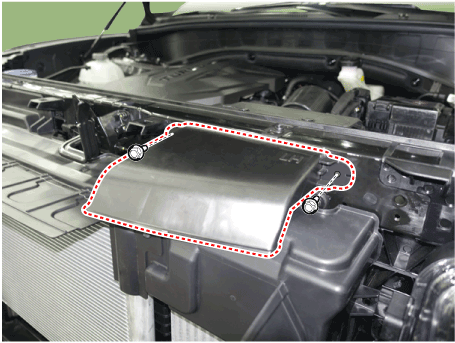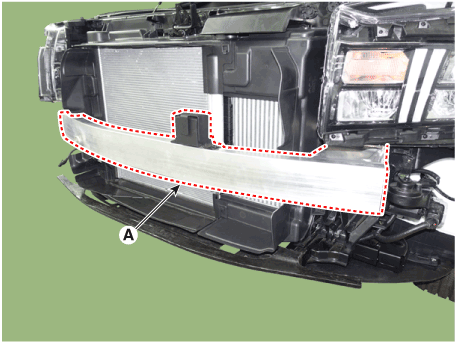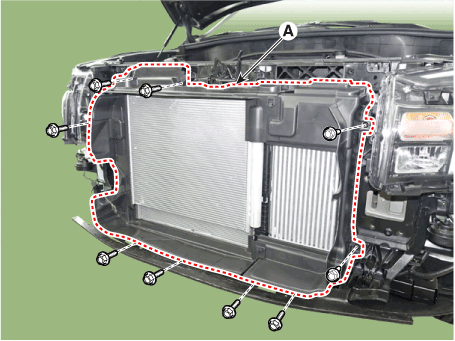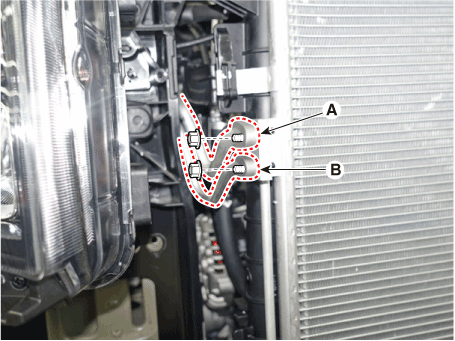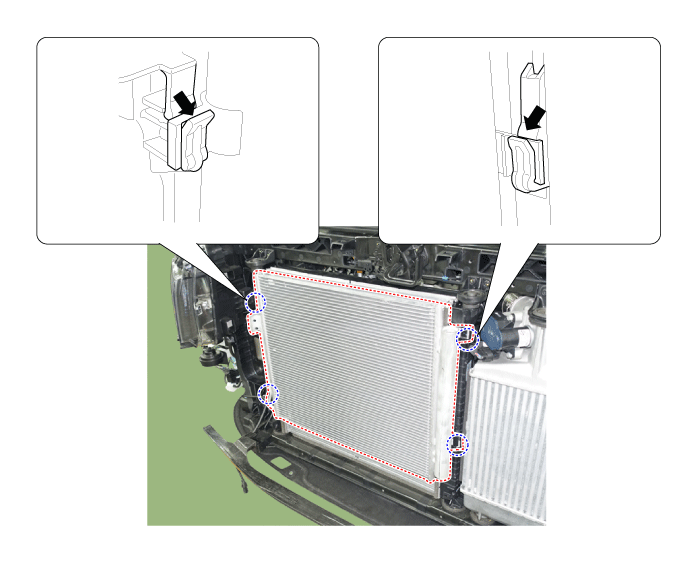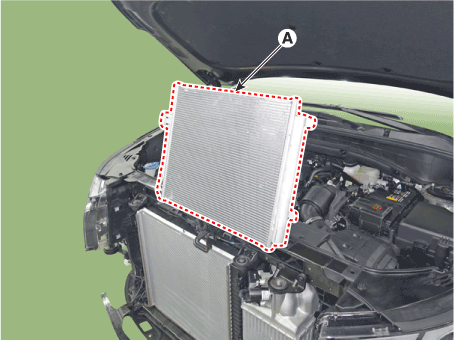Hyundai Santa Fe: Air conditioning System / Condenser. Repair procedures
Hyundai Santa Fe (TM) 2019-2025 Service Manual / Heating,Ventilation And Air Conditioning / Air conditioning System / Condenser. Repair procedures
| Inspection |
| 1. |
Check the condenser fins for clogging and damage. If clogged, clean
them with water, and blow them with compressed air. If bent, gently
bend them using a screwdriver or pliers.
|
| 2. |
Check the condenser connections for leakage, and repair or replace it,
if required.
|
| Replacement |
| 1. |
Recover the refrigerant with a recovery/recycling/charging station.
|
| 2. |
Disconnect the negative (-) battery terminal.
|
| 3. |
Remove the front bumper.
(Refer to Body - "Front Bumper Assembly")
|
| 4. |
Remove the hood latch assembly.
(Refer to Body - "Hood Latch Assembly")
|
| 5. |
Loosen the mounting bolts, remove the air duct (A).
|
| 6. |
Loosen the mounting bolts and nuts, remove the front bumper beam assembly
(A).
|
| 7. |
Loosen the mounting bolts and screws , remove the upper air guard (A).
|
| 8. |
Loosen the mounting nuts and separate the discharge line (A) and liquid
line (B).
|
| 9. |
Press the lock pin and remove the condenser assembly (A) from radiator
assembly.
|
| 10. |
Install in the reverse order of removal.
|
 Receiver-Drier. Repair procedures
Receiver-Drier. Repair procedures
Replacement
1.
Using a Lwrench, remove the cap (A) on the bottom of the receiver-drier.
2...
Other information:
Hyundai Santa Fe (TM) 2019-2025 Owner's Manual: Auto door lock/unlock features
Your vehicle is equipped with features that will automatically lock or unlock your vehicle based on settings you select in the infotainment system screen. Auto LOCK Enable on speed When this feature is set in the infotainment system screen, all the doors will be locked automatically when the vehicle exceeds 9 mph (15 km/h)...
Hyundai Santa Fe (TM) 2019-2025 Service Manual: Front Seat Belt Buckle. Repair procedures
Replacement 1. Remove the front seat assembly. (Refer to Front Seat - "Front Seat Assembly") 2. Disconnect the front seat belt buckle connector wiring (A). 3...
Categories
- Manuals Home
- 4th Generation Santa Fe Owners Manual
- 4th Generation Santa Fe Service Manual
- Gauges and meters
- Electronic child safety lock
- Body (Interior and Exterior)
- New on site
- Most important about car
Air bag collision sensors
WARNING
To reduce the risk of an air bag deploying unexpectedly and causing serious injury or death:
Do not hit or allow any objects to impact the locations where air bags or sensors are installed. Do not perform maintenance on or around the air bag sensors. If the location or angle of the sensors is altered, the air bags may deploy when they should not or may not deploy when they should. Installing bumper guards with nongenuine Hyundai or non-equivalent parts may adversely affect the collision and airbag deployment performance. Press the Engine Start/Stop button to the OFF or ACC position and wait for 3 minutes when the vehicle is being towed to prevent inadvertent air bag deployment. Have all air bag repairs performed by an authorized HYUNDAI dealer.
Copyright © 2025 www.hsafe4.com

